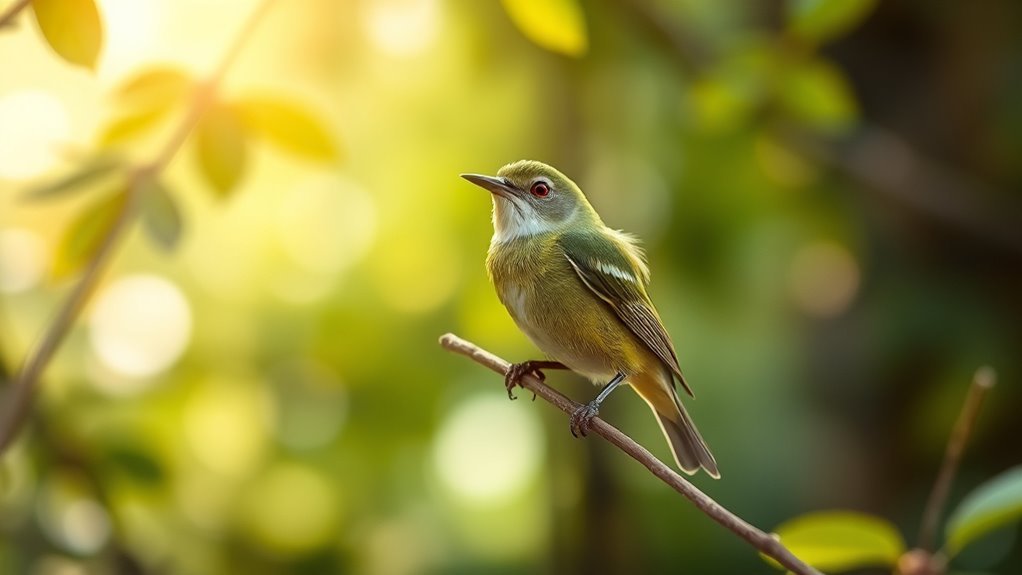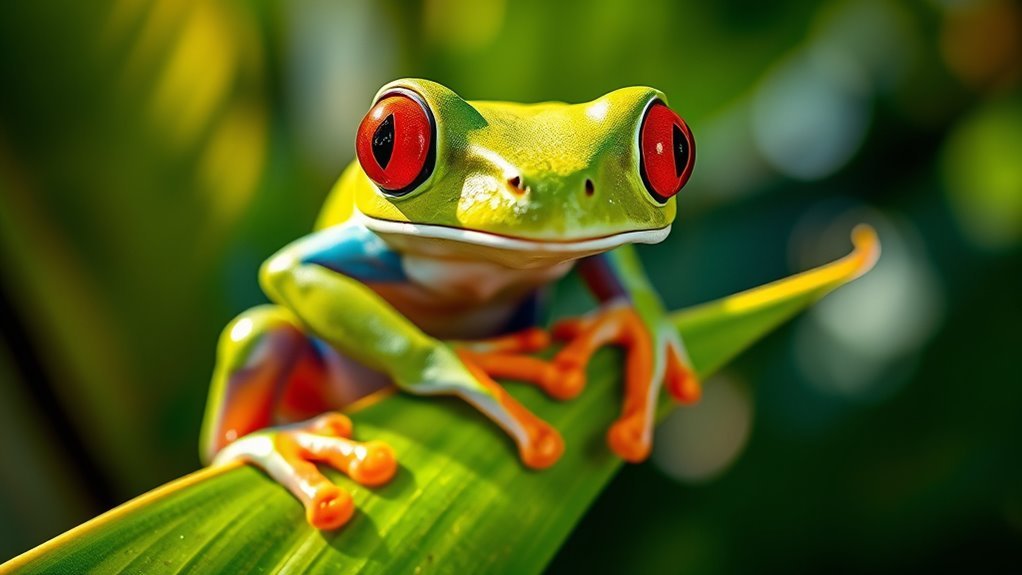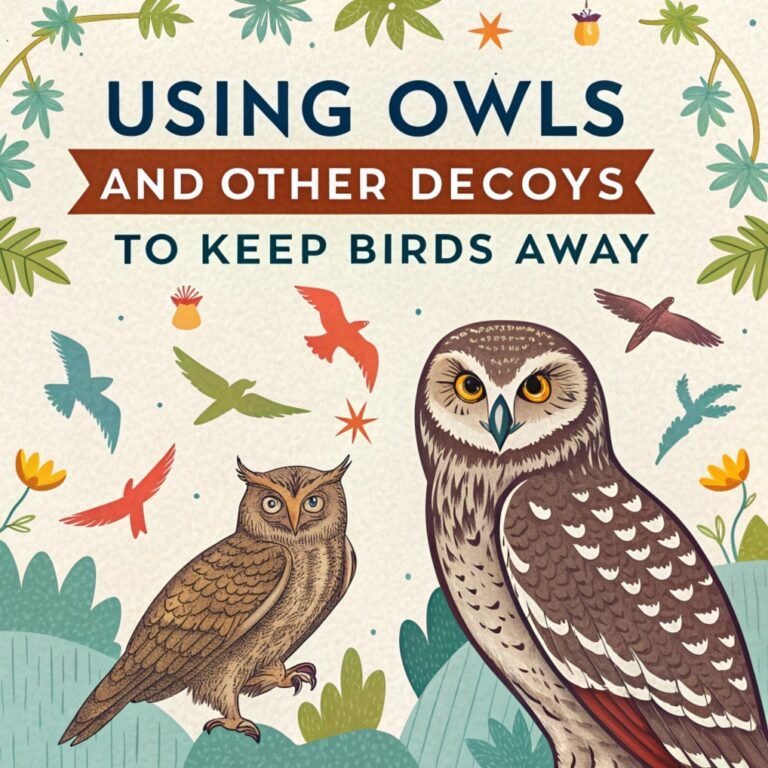Birds With Strikingly Bright Red Eyes: Identification Guide
Birds with bright red eyes capture attention and showcase unique traits. The Red-eyed Vireo and Common Redpoll exemplify this with special behaviors and specific living environments. Observing them reveals how these features aid in their survival. Their distinct songs and feeding methods highlight their roles in nature. This information invites curiosity about these remarkable bird species.
Key Takeaways
- Red-eyed Vireo features notable red eyes, thrives in deciduous forests, and is recognized for its melodious songs and social foraging behavior.
- Common Redpoll is a small finch with bright red eyes, known for impressive acrobatics while feeding on seeds in flocks.
- Scarlet Tanager showcases a striking bright red body with black wings and tail, often heard calling sharply from high tree perches.
- Ruby-throated Hummingbird has a vibrant red throat and green feathers, renowned for its swift flying and migratory patterns from Central America.
- Observing these birds' habitats and behaviors enhances appreciation and identification of their striking eye features in the wild.
The Mysterious Red-eyed Vireo

The red-eyed vireo (Vireo olivaceus) is an interesting bird that often hides in the leaves. Its notable red eyes make it stand out.
These small birds prefer living in deciduous and mixed forests with thick foliage, which keeps them safe and provides plenty of food.
You can see their unique behavior, like quick flutters and head tilts, as they look for insects and berries. Their beautiful songs add a special sound to the trees around them.
They're social animals and often forage alongside other birds, which allows you to feel more connected to nature.
Watching their daily activities can help you appreciate this mysterious bird that inhabits the woods.
The Dazzling Scarlet Tanager
The scarlet tanager (Piranga olivacea) is a striking bird known for its bright red body and contrasting black wings and tail.
It mainly lives in deciduous forests, especially near edges and clearings, where it searches for insects and fruits.
This bird is often hard to spot as it prefers to stay high in the trees.
You can recognize it by its sharp, whistled calls that resonate through the forest.
Watching a scarlet tanager in flight, with its vivid colors, connects you to the beauty of nature and invites you to appreciate the wonders around you.
The Enigmatic Common Redpoll

The common redpoll (Acanthis flammea) is a small but captivating finch. It has striking red eyes and a petite body. Birdwatchers enjoy spotting this bird.
During breeding season in late spring, redpolls engage in courtship rituals and often gather in loose flocks.
These birds primarily eat seeds from grasses and trees. They display impressive acrobatic skills as they cling to seed heads.
Observing their feeding and social interactions can deepen your appreciation for these birds. Each sighting reveals a beautiful aspect of nature.
The Striking Ruby-throated Hummingbird
The ruby-throated hummingbird (Archilochus colubris) is one of the most colorful birds in North America. This small bird has shiny green feathers and a bright red throat.
It's known for its swift flying abilities. In spring, these hummingbirds migrate thousands of miles from Central America to their breeding grounds.
You can see them as they flit from flower to flower, feeding mainly on nectar, which is a key part of their diet. They also eat small insects and spiders for protein.
Learning about their habits and diet can help you set up your garden to attract these beautiful birds, allowing you to enjoy their presence.
The Majestic Red-eyed Tree Frog

The red-eyed tree frog (Agalychnis callidryas) stands out with its bright colors and unique traits. This frog lives in the forests of Central America.
Its red eyes serve an important purpose. When a predator approaches, the frog opens its eyes wide to show its vivid red irises. This sudden display can scare off threats.
The frog's green body helps it blend into its leafy surroundings, providing excellent camouflage. By watching this species, you can see its agility and intelligence.
These frogs thrive in humid, tropical areas, making them an important part of their ecosystem. Protecting them helps maintain a rich natural environment.
Engaging with the red-eyed tree frog can enhance your appreciation of nature.
The Vibrant Vermilion Flycatcher
The vibrant vermilion flycatcher (Pyrocephalus rubinus) stands out with its bright red feathers and active nature.
This bird thrives in open woodlands and shrubby areas near water in the southwestern United States and Central America.
Males perform vivid displays, puffing up their colorful feathers to attract females.
These flycatchers are skilled hunters. They chase insects mid-air and often perch on low branches, alert and ready to catch their next meal.
Their energetic presence adds color to your birdwatching experiences, allowing you to enjoy the beauty of nature.
The Elegant Red-shouldered Hawk
Red-shouldered hawks (Buteo lineatus) are striking birds. They soar gracefully over wooded areas.
These raptors often perch near waterways, displaying their vibrant red shoulder feathers. They prefer habitats with rich, wooded landscapes that provide good hunting opportunities.
Here are some interesting traits of red-shouldered hawks:
- They've distinctive red feathers on their shoulders.
- They possess sharp eyesight to spot prey easily.
- They use different hunting methods, such as gliding and pouncing.
- Their vocal calls can be heard echoing through the woods.
- They build nests in tall trees near water sources.
These features make red-shouldered hawks both beautiful and skilled hunters.
Frequently Asked Questions
What Causes the Bright Red Eye Coloration in These Birds?
Bright red eye coloration in birds comes from their eye structure and genetics. This color helps them see better in their environments. Each bird species has its unique adaptations that help it survive in various habitats. These adaptations are important for their daily activities and overall survival. Understanding these traits can give us insight into how birds interact with their surroundings.
Where Can I Find These Birds in the Wild?
To find these birds in the wild, visit birdwatching spots like wetlands or forests. They like areas with thick vegetation where their vibrant colors are easy to see. This makes birdwatching exciting and enjoyable for enthusiasts like you.
Are Red-Eyed Birds More Susceptible to Predators?
Red-eyed birds may be more noticeable to predators. They use camouflage and specific flight patterns to escape from threats. These strategies help them survive in their habitats and avoid dangers.
Do the Eye Colors Change With Seasons or Age?
Eye colors can change with the seasons and as birds age. As they grow older, their eye colors may shift due to breeding cycles, light conditions, and health. These changes can reveal interesting aspects of their biology and development.
What Do Red-Eyed Birds Typically Eat?
Red-eyed birds eat a variety of foods. They commonly eat insects, fruits, and seeds. Their diet changes with the seasons based on what food is available. This change helps them get the nutrients they need and supports their bright colors and energy levels.

Hello, I’m Amelia White, the founder of birdsfanatic.com. As a lifelong bird enthusiast and spiritual seeker, I’ve always been fascinated by the mystical connections between birds and the human experience. On this site, I share my knowledge and insights into the symbolic meanings and spiritual significance of various bird species, exploring their roles in mythology, folklore, and cultural traditions. Join me on this journey into the world of birds, where we’ll discover the hidden wisdom and guidance that these magnificent creatures have to offer.







